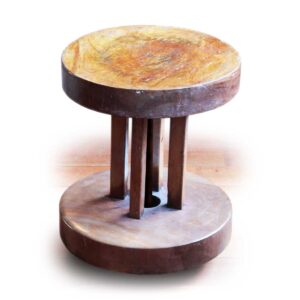
One of the tools used in ceramic molding. The potter’s wheel is turned by kicking the periphery of one of the disks with his or her feet to form the desired product by hand. In Japan, the hand wheel is more common in the Tohoku region than in Owari and Mino (Aichi and Gifu prefectures), while the kick wheel is more common in the Kyushu region than in the Kansai region. However, Kutani ware in Ishikawa Prefecture and Hirakiomizu ware in Yamagata Prefecture use the kick wheel. In the Kyushu region, it is called “kekuruma” or “monokuruma. In Japan, two zelkova disks (upper and lower) are connected with four oak square rods (about 25 cm long and 3 cm thick), and these four rods are tightly wound around the connecting structure with ropes. The lower disk is drilled with a hole in the center for the vertical axis to pass through. The connecting disks thus assembled are supported at their lower end by the pointed end of a vertical oak shaft buried in the ground, and the lower disk is kept in a stable position where it touches the vertical shaft. When molding with this machine, a well-kneaded piece of clay is adhered to the center of the upper disk, and the lower disk is kicked with the foot to create a rotating motion, utilizing centrifugal force to mold the object. For archaeological and ethnographic facts and views, see “Rokuro” by G. Wooster, translated by Makoto Sawara.


